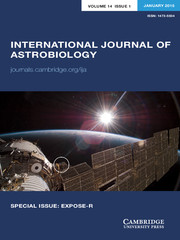Crossref Citations
This article has been cited by the following publications. This list is generated based on data provided by
Crossref.
Rugheimer, S.
Segura, A.
Kaltenegger, L.
and
Sasselov, D.
2015.
UV SURFACE ENVIRONMENT OF EARTH-LIKE PLANETS ORBITING FGKM STARS THROUGH GEOLOGICAL EVOLUTION.
The Astrophysical Journal,
Vol. 806,
Issue. 1,
p.
137.
Cuntz, M.
and
Guinan, E. F.
2016.
ABOUT EXOBIOLOGY: THE CASE FOR DWARF K STARS.
The Astrophysical Journal,
Vol. 827,
Issue. 1,
p.
79.
Sato, S.
Wang, Zh.
and
Cuntz, M.
2017.
Climatological and ultraviolet‐based habitability of possible exomoons in F‐star systems.
Astronomische Nachrichten,
Vol. 338,
Issue. 4,
p.
413.
LoPresto, Michael C
and
Ochoa, Hector
2017.
Searching for potentially habitable extra solar planets: a directed-study using real data from the NASA Kepler-Mission.
Physics Education,
Vol. 52,
Issue. 6,
p.
065016.
O’Malley-James, Jack T
and
Kaltenegger, L
2018.
Biofluorescent worlds: global biological fluorescence as a biosignature.
Monthly Notices of the Royal Astronomical Society,
Vol. 481,
Issue. 2,
p.
2487.
Perryman, Michael
2018.
The Exoplanet Handbook.
Seach, J M
Marsden, S C
Carter, B D
Evensberget, D
Folsom, C P
Neiner, C
and
Mengel, M W
2021.
The magnetic fields and stellar winds of the mature late F-stars: β Virginis and θ Draconis.
Monthly Notices of the Royal Astronomical Society,
Vol. 509,
Issue. 4,
p.
5117.
Hey, Daniel R.
Montet, Benjamin T.
Pope, Benjamin J. S.
Murphy, Simon J.
and
Bedding, Timothy R.
2021.
A Search for Transits among the Delta Scuti Variables in Kepler.
The Astronomical Journal,
Vol. 162,
Issue. 5,
p.
204.
Kipping, David
2021.
Formulation and resolutions of the red sky paradox.
Proceedings of the National Academy of Sciences,
Vol. 118,
Issue. 26,
Varela, J.
Brun, A. S.
Zarka, P.
Strugarek, A.
Pantellini, F.
and
Réville, V.
2022.
MHD Study of Extreme Space Weather Conditions for Exoplanets With Earth‐Like Magnetospheres: On Habitability Conditions and Radio‐Emission.
Space Weather,
Vol. 20,
Issue. 11,
Patel, M.R.
Mason, J.P.
Nordheim, T.A.
and
Dartnell, L.R.
2022.
Constraints on a potential aerial biosphere on Venus: II. Ultraviolet radiation.
Icarus,
Vol. 373,
Issue. ,
p.
114796.
Perez, Karen I.
Farah, Wael
Sheikh, Sofia Z.
Croft, Steve
Siemion, Andrew
Pollak, Alexander W.
Brzycki, Bryan
Cruz, Luigi F.
Czech, Daniel
DeBoer, David
Drew, Jamie
Gajjar, Vishal
Garrett, Michael A.
Isaacson, Howard
Lebofsky, Matt
MacMahon, David H. E.
Premnath, Pranav H.
Pater, Imke de
Price, Danny C.
Schoultz, Sarah
Wlodarczyk-Sroka, Bart S.
Tarter, Jill
and
Worden, S. Pete
2022.
Breakthrough Listen Search for the WOW! Signal*
.
Research Notes of the AAS,
Vol. 6,
Issue. 9,
p.
197.
Anslow, R. J.
Bonsor, A.
and
Rimmer, P. B.
2023.
Can comets deliver prebiotic molecules to rocky exoplanets?.
Proceedings of the Royal Society A: Mathematical, Physical and Engineering Sciences,
Vol. 479,
Issue. 2279,
Wittmayer, Blake H.
and
Cuntz, Manfred
2023.
The quintuple system 30 Arietis: Comments on orbital stability and habitability.
Astronomische Nachrichten,
Vol. 344,
Issue. 5,


